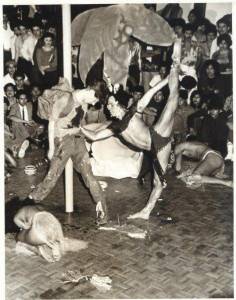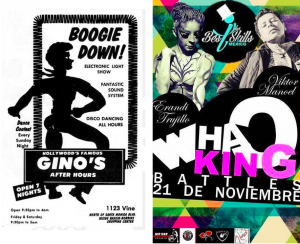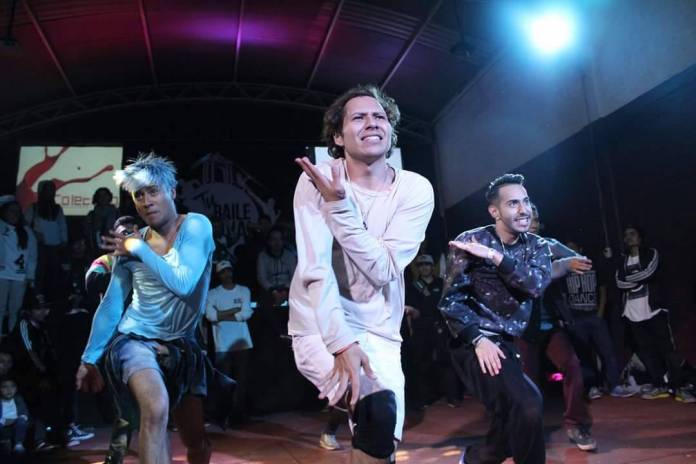
MEXICO CITY, MEX. — Maybe it’s cliché, but it’s also true that vogue and whacking – the latter a dance that sprung up in LA disco and funk clubs as vogue surged in 1970s Harlem — arrived in Anuar “Any Funk” Alvarado’s life just as he needed it. The Mexico City dancer tells 48 Hills he, “started dancing vogue and whacking because I was in the process of coming out of the closet. It was my way of expressing myself, better than dancing hip hop.” He can present different aspects of himself, he says, with forms of movement that come from gay communities, even if that community originated thousands of miles away.
Given vogue’s global spread, it would seem that he’s not the only one. In 2015, dance events labeled “ballrooms” took place from Moscow to Helsinki to Hong Kong. Top vogue DJs from New York and New Jersey spent the year criss-crossing the world, providing an authentic soundtrack for far flung groups that have taken enthusiastically to this most recent resurgence. And though it’s not at the same saturation point as vogue, whacking has also spread far past its origin point, with international competitions featuring participants from Asia and Europe.
Pop culture, of course, also took to vogue this past year. Well-reasoned cries of alarm rang out when the form popped up every where from FKA Twigs’ videos to Magic Mike XXL, asking what the erasure of vogue’s poor, trans and POC roots would mean for its original communities.
But smart dancers aren’t down for art without context. Which is why, last month in a Mexico City dance studio, Any Funk was among a small group that had gathered to be taught by Los Angeles Pilates studio owner and longtime urban dancer Viktor Manoel. The visiting instructor is one of the original practitioners of whacking, and has made it his mission to reinforce the dance’s queer roots and history.
Any Funk has been in contact with Manoel for years, meeting at whacking events on both sides of the border. The younger dancer helped him organize this recent tour of Mexico. Starting in 2008, Any Funk has taken an active role in spreading the movements of disperse dance traditions in Mexico. He’s been one of the most visible faces of vogue dancing in Mexico City and one of the founding members of House of Machos, which might be the country’s first vogue and whacking crew. Several houses have appeared in DF over the past few years and at least one major ballroom event (spearheaded by star local experimental music label NAAFI and featuring Vogue Knights legend DJ Mike Q) got international media coverage in September. Information about upcoming local vogueing and whacking classes are best obtained from House of Machos’ Facebook page.

Like his younger counterpart, Manoel came to whacking at a time when he was still grappling with how to express his sexuality. “The 1970s was not a fun time for us,” he says. “There were literally commercials on TV with Anita Bryant saying that we should be condemned, put in jail, that we were perverts.” The first time that he went to the Paradise Ballroom, one of the eventual home bases of his whacking crew, the exuberant queerness of the club scared the 17 year old. “I looked around and thought, ‘oh my god are we going to get busted? Are we going to go to jail?’”
But a multiracial group of gay boys quickly dismantled his fear. Manoel realized that like him, others had begun dancing to disco beats in ways that went way past the Hustle: by imitating action movies, the grand dames of Hollywood, even Frankenstein. Unlike vogue, you didn’t face down your fellow dancers. “The OG battle was between DJ and dancer,” says Manoel. And where vogue had the pages of fashion magazines and the runway, the whackers took their inspiration from anything that seemed to mock the beats they flourished to.
“We were punking the music,” says Manoel. That’s what they originally called their dance — “punking,” a queer takeback of a word that at the time was also used to refer to prison bottoms. It’s later version “whacking”, Manoel says, was taken from the campy sound effects on the Batman and Robin TV show and first used in straight clubs where dancers feared their heterosexual crushes would bridle at punking’s connotations. He repeatedly mentions “whack”’s dictionary definition as a sign of the dance’s radical power for its participants: “to strike with force.”
Help us save local journalism!
Every tax-deductible donation helps us grow to cover the issues that mean the most to our community. Become a 48 Hills Hero and support the only daily progressive news source in the Bay Area.
Punking was a way to strike back.
Eventually the dance spread beyond LA. Dancer Tyrone Proctor took the form to Japan through the Soul Train tour, and Manoel found professional success as a dancer, even touring internationally with Grace Jones during her Do or Die and Muse eras. Whacking appears in Staying Alive (1983) the popular Breakin’ series of movies that began in 1984. But somewhere in this rapid diffusion, Manoel says the form was divorced from its roots. In 2009, he says choreographer Tony Basil convinced him that whacking needed its OGs to come back and clarify its origins. His trip to Mexico was an attempt to reintroduce the form’s context to young dancers.
Viktor Manoel and his friend Tommy back up dance for Grace Jones on Canada’s The Raes TV series
Michoacán-born Manoel (his family moved to Culver City when he was 7) was called south when he saw that whacking was gathering its adherents in his homeland. He bridled at posts he saw on Facebook that seemed to represent these new dancers’ tendency to fashion themselves into divas before they’ve put in their time. After all, “Everyone wants to be stars, but it’s the style that has to be the star,” says Any Funk, reciting a lesson he learned from Manoel himself.
That’s how the Paradise Ballroom original knew he was needed further south. Queer history is lost so easily between generations, so in each class he impresses upon students the fact that he is one of the only ones of the original whackers to survive the AIDS epidemic, to make it to see the re-emergence of the dance form he helped invent.
He’d would like to see Mexico step up when it comes to whacking and vogue’s resurgences, put some local flavor into its mix. He puts out a call for fusion. “Who is to say that Mexico, with all this history and culture that we have, can’t do that?” he says. “Why don’t we put our Aztec and Mayan culture on these vogue beats?”
“He wants Mexico to make more noise within the genre,” Any Funk says. “He wants to teach people that we can do this, so that Mexico’s name is heard around the world.”
Those heels though: Viktor Manoel whacks with the House of Ninja’s Archie Burnett in 2013.
Any Funk insists that whacking has been present in Mexico for some time. For proof, he points at the city’s notorious, Friday night only Hi NRG and Italo disco club Patrick Miller, where Mad Max-looking dancers battle with high kicks, twirls and fluttering hand movements in a room that can best be described as airplane hanger-like. “Patrick Miller used to be a sonidero (traveling sound system),” Any Funk theorizes about this correlation. “Whacking was passed down across the border when it played shows in Tijuana and Monterrey.”
Though his younger dancer friends have tried to get him to check out the Patrick Miller, Manoel’s more focused on the younger dancers in his classrooms. “I don’t stand in line,” he says. “And if I want to dance, I’m going to use the entire floor and there’s just no room there.” Any potential similarities he chalks up to older people who were privy to whacking’s popularity in ‘80s pop culture.

For his part, Manoel doesn’t focus overmuch on what it means that these dance forms have moved from the underground clubs of a specific city out onto the world stage. What he sees is the potential for family and self respect that vogue and whacking can bring to informed new practitioners – values that saved him as a young dancer from Culver City. The dance can be healing to young people dealing with prejudice from just about anywhere, really. “What’s the groove of punking/whacking?” he asks. “I say it’s to create something beautiful from something ugly.”
The last thing he says in his interview is that he’s sending over a list. They turn out to be the names of his friends in the original punking scene, everyone who didn’t make it to see what whacking looks like in 2015. We promise to run it, an invocation of those who came before.






